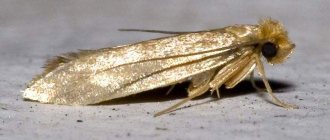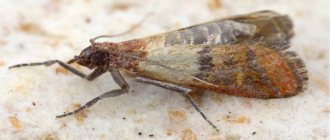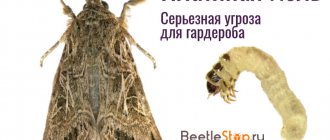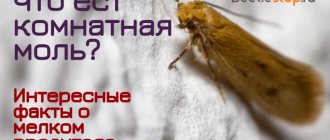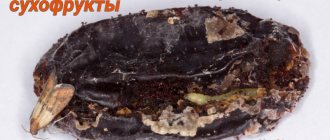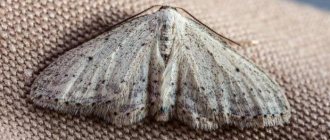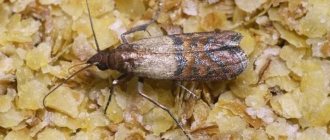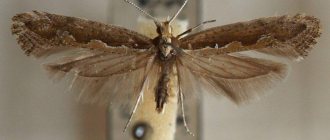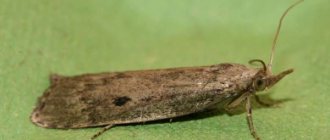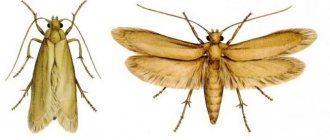What does a thing moth look like (photo)
Clothes moth.
Methods of disposal
If you find butterflies or their larvae, you must get rid of clothes moths in your apartment.
The presence of pests can lead to damage to furniture and clothing. The clothes moth has an average level of vitality; to remove the insect, you can use not only chemical toxic substances, but also home methods.
Chemicals
House moths, like any other household pest, are destroyed by insecticides in the form of tablets, powders, aerosols, and traps. An excellent way to help eliminate parasites is to use a spray. To remove moth larvae and kill adult butterflies, it is enough to spray a small amount of aerosol in the room and treat the inside surfaces of cabinets and clothing with it.
You can also use toxins presented in the form of tablets and powders. Almost all of them are designed to be placed in typical locations where moth larvae are located. They can be used both to destroy pests and to prevent the appearance of parasites.
Liquid and plates
Clothes moths can cause a lot of trouble, and it is important for everyone to know how to get rid of pests. The simplest and most affordable way is to use fumigators - devices whose operating principle is to heat a liquid or plates and then evaporate toxic substances.
Such devices are safe for human health and pets, which can be considered one of the undeniable advantages.
Common fumigator options that have some differences in price are Dick-3, Raptor, and Raid. Manufacturers of the above devices also produce plates and insecticidal liquid. To get the desired effect, just turn on the purchased device via an outlet. There is no need to leave your home while the fumigator is in effect.
A significant disadvantage of this method is the lack of a harmful effect on parasite larvae. To destroy the entire population, it is necessary to periodically treat the apartment and combine the use of a fumigator with other methods. Only if the specified conditions are met can you get rid of clothes moths.
Folk remedies
Unlike other household pests, clothes moths can be dealt with using traditional methods.
The main ones:
- Exposure to high temperatures. To destroy the larvae, it is enough to wash things by hand or using a washing machine. For greater efficiency, it is recommended to boil the laundry. Additionally, steam treatment is used.
- Exposure to low temperatures. If items cannot be washed with hot water, freeze them. To do this, hang the clothes out in the cold, leaving them there for several hours.
- To repel parasites, place plants that have a distinct odor that is unpleasant for parasites in cabinets. Suitable: wormwood, tansy, lavender.
Before using any method, it is recommended to thoroughly shake out or vacuum the clothing. The larvae of parasites are easily shaken out of things; they can be destroyed using simple mechanical methods.
Important! It is not recommended to use naphthalene. This product is effective, but is harmful to the health of humans and animals.
Video
How to get rid of moths?
Main characteristics of the pest
Name: House moth Lat.:
Tineola bisselliellaClass: Insects - Insecta. Order: Lepidoptera - Lepidoptera. Family: True moths - Tineidae.
| Habitats: | cabinets, furniture |
| Dangerous for: | fabrics, furs, upholstery |
| Means of destruction: | traditional methods, chemicals, traps. |
Moth caterpillars.
Many people mistakenly believe that if their home is kept in order and clean, then these pests are not afraid of them. But in vain, because moths do not start from dirt.
She loves things made from natural fabrics such as wool and fur. She does not disdain cereals or other loose ingredients left unattended in the kitchen.
Such components are present in every home, so you need to always be on guard. In addition, if there is a moth in a neighboring apartment, then it is possible that it can get into the home through open doorways, vents, or cracks.
You can bring it with purchases from the store, with things or furniture that were used by other people.
What does it look like and where does it lay eggs?
The clothes moth looks like a fairly large butterfly. Its wingspan reaches 23 millimeters. The color of the wings is predominantly sandy, with a purple tint at the base.
She lays eggs in dark, hard-to-reach places, in folds of fabric, under collars and cuffs, in pockets, and in the recesses of textile seams.
Life cycle
The complete development cycle from egg to butterfly takes from one to two and a half years. Having hatched from the pupa, the butterfly immediately looks for a sexual partner and mates. In two weeks she lays about 50 eggs. After laying eggs, which takes seven days, the female lives for a few more days and dies. The male continues to mate until the end of his life.
Life cycle of a moth.
Damage
Moth damage on clothing.
Adult larvae crawl on clothes and furniture. The most dangerous are only the larvae that hatch from the eggs. They destroy and chew everything in their path, even synthetics and plastic bags.
Once the toothy larva has reached the item, all that remains is to throw it away. Such things, as a rule, cannot be restored.
What does it eat?
Clothes moths usually live in closets, furniture, attics, pantries, and anywhere there are fabric-upholstered items and clothing. Their favorite food is fur coats, woolen items, linen, cotton, natural angora, silk, and cashmere.
Prevention measures
Moths can easily appear in any apartment, regardless of sanitary conditions. At the same time, she does not stay in every apartment due to unfavorable conditions. Since they cannot lay eggs under their usual conditions, they have nothing to do in such a dwelling. By following a number of very simple rules, you can reliably protect your home from pests.
You need to proceed as follows:
- Regularly ventilate closets where clothes are stored, and at the same time check things for the presence of such pests. Particular attention should be paid to items made of fur, leather, knitted items, and natural wool.
- Take things outside or onto the balcony if it is open. This can be done both in summer and winter. The larvae die both from ultraviolet rays and from sub-zero temperatures.
- Items made from natural fur should be stored correctly, without using polyethylene. To do this, use special covers, pre-treated with chemicals, or put leaves of tobacco, wormwood, lavender and other plants wrapped in gauze in your clothing pockets.
- Bulk food products also need to be stored properly in closed containers. Do not purchase bulk food products for a long period - a couple of weeks maximum. If cereals or flour are stored for a long time, then pests will definitely appear in them.
How to get rid of clothes moths
It is quite difficult to remove clothes moths. Moreover, considering the fact that caterpillars can go without food for a month. There are folk, chemical and professional means of insect control.
Regular monitoring
In order to minimize the risk of invasion, regular inspections are carried out in cabinets and shelves. Both butterflies and larvae cannot exist without giving themselves away. In their habitats there will certainly be damaged areas of tissue, gnawed pieces of fur, threads of cobwebs, cocoons and feces.
If you suspect the presence of unwanted guests, you should react immediately, otherwise trouble cannot be avoided.
Preventing or reducing infestations
Cleaning a living space infested with clothes moth larvae should be carried out with special care.
- It is necessary to pay attention to hard-to-reach places: behind radiators and ventilation holes, under baseboards and wardrobes.
- Wipe shelves and furniture with a special disinfectant.
- When using a vacuum cleaner, upon completion of work, you must immediately dispose of the contents of the dust collection bag so that the larvae and eggs that get there cannot return again.
If moths are found in a closet, you should remove all items from there and wash all surfaces.
Protecting things in the closet
Sachet for the closet.
Clothes and other items left in the closet without proper care are most susceptible to insect attacks.
Therefore, they should be stored in clean, dry form, in sealed containers, pre-treated with natural repellents, for example, mint, lavender, wormwood, or use special chemicals, dichlorvos.
Freezing and heating
Moths do not like low or high temperatures.
Moth butterflies die when there is a sharp change in temperature, and it does not matter in which direction this difference occurs. This could be temperatures above 50 or below 20 degrees Celsius.
The product, previously placed in plastic packaging, is either fried in an oven or frozen in the freezer. It all depends on the type of fabric: if it is not afraid of these types of processing, then you can safely take them into service.
Dry cleaning will help get rid of moth larvae.
The contents of the closet are reviewed for damage, and surviving clothes are washed and fried at high temperatures. Bright sunlight is not a moth's best friend; it dies in the light.
Washing is done at a temperature of at least 50 degrees and for a duration of at least half an hour. Textiles that cannot be washed at high temperatures should be dry cleaned.
Traps
Sticky trap.
Another method of control is glue pheromone traps. This is the simplest, most accessible and relatively cheap method. The principle of its operation is very simple.
The female follows the smell emanating from the trap and sticks her paws to the glue, gets stuck there and dies. You can purchase it at any specialized institution.
Peculiarities
An adult moth reaches 9 mm in length in the photo. Its color is quite inconspicuous, having a light yellow or straw color. Indoor flights are performed by males. Female insects have wings, but they never use them. Usually the female is in one place; for fertilization, the male finds her on his own. The moth then lays eggs, the larvae of which are the main pest.
Preventive measures
Folk remedies are often used as prevention.
Repellent plants are able to repel insects and moths with their specific aroma.
Their effect is longer than that of chemical drugs, but they are less dangerous to the health of people and pets. These include tobacco, garlic, vinegar, geranium, lily, mint, lavender, rosemary, citrus peel and many others.
Follow this link to learn more about all the ways to get rid of moths.
Larvae
These transitional insect organisms are the most important pests. Caterpillars eat a large amount of lint, which is why bald spots and holes are clearly visible on products. The larva has a white or yellowish color and is small in size. The head of the caterpillar has a brown tint, and small legs are located on the body. The body is adapted to active movement and eating surfaces. Usually there are no holes on fur products, but as the insect moves, a gnawed path remains. Moth larvae are easily transported from one place to another along with clothing, so moths can be brought in if old things were brought into the house from outside.
At the first sign of flying insects, it's a good idea to inspect your closets and carpets. All damaged items must be removed. Treatment for prevention is carried out several times a year.
See also: How to destroy a pest with your own hands?
Regular monitoring
In order to check for the presence of pests, the first thing you need to pay attention to is whether there are threads of cobwebs in hidden parts of clothing. It is also possible that there are tubes left behind after insects pupate. The area where these tubes are most common tends to have a lot of damaged clothing fibers and insect feces. The same picture can be observed in fur items, where, among other things, baldness can be observed, and when lightly tugging on the remaining fur, it will separate in large clumps.
Lifespan
Hardly anyone thought about how long a moth lives. She cannot be considered a long-liver. The total lifespan of a winged individual is from 2 to 4 weeks, depending on the type of moth. Insects move and fly little. The main activity occurs at dusk, as they are good prey for any predator.
To reach sexual maturity, the moth must go through certain stages of development:
- the female lays eggs twice a year, from which caterpillars appear two weeks later, the temperature is +20 degrees, which is favorable for the development of offspring;
- Moth larvae form a nutritious cocoon around themselves, where they develop for 3-10 months.
If we consider the full life cycle of an insect, then moth eggs go through a long stage of development to the state of an adult, all this time feeding on the materials and products in which they live.
Variety of species
House moths are small insects whose wings are up to 7 mm long and form a triangle when folded. These pests differ in their color to a small extent, since for the most part they are quite inconspicuous and inconspicuous.
If we consider the ermine moth, it will differ not only in its bright color, but also in the way it folds its wings - it is no longer a triangle, but a pyramid. The wallflower also stands out for the colorfulness of its wings, which when folded look like a narrow tube.
Some pests have a unique color that helps them camouflage perfectly. This is necessary mainly for species living in the wild, since they are unable to fly long distances and they also lack any means of protection.
Types of flying insects
Household moth is a general term for all varieties of insects that can get into an apartment and ruin your favorite clothes and groceries. They differ in their feeding habits and external characteristics. There are six types.
- Clothes moth. Light yellow butterfly with a lilac tint on the wings. The larvae of the parasite are white, with powerful jaws, and feed on soiled areas of clothing, gnawing them to holes.
- Fur moth. A white moth with black spots on its wings. Caterpillars eat products made of fur, velvet and wool. Standard cellophane clothing bags do not pose a barrier for them.
- Furniture moth. Butterfly with yellow-gray wings. The larvae eat sofa upholstery and fur items. They live inside furniture or in closets.
- Buffalo bug. The moth is dark brown in color with specks on the wings. Lives in carpeting, gradually eating fluffy pile.
- Wood moth. A small moth that climbs into apartments for the winter.
- Food moth. The butterfly is brown or gray in color, belongs to the moth family, the wingspan does not exceed 15 mm. Lives in the kitchen, eating groceries.
Dry cleaning and anti-laundering
The most common and effective method for killing all life stages of moths in clothing, blankets and other washable items is classic washing or laundering. A thorough washing process should not take less than 20-30 minutes in water that is heated to at least 50 degrees Celsius. Since many woolen items should not be washed in hot water, dry cleaning these items may be the only viable option. Storing clean fabrics has another benefit - insects are less likely to infest them.
Traps
Traps are a relatively easy-to-use method that can help detect and reduce clothes moth infestations. Pheromone traps are available in specialty stores and are relatively inexpensive. Pheromones are chemicals produced by the body of a male insect, which in this case is a sex attractant that can influence the behavior of other members of the same species.
The sex pheromone lures females into the trap, where they become stuck on its sticky sides. Since the pheromone specifically attracts only moths, it will not attract other types of insects.
Damage
The larval stage of the insect is the destructive stage of the moth's life. Insects feed on the wool of outerwear, carpets and rugs, as well as upholstery of upholstered furniture, furs, animal hair, felt pads in musical instruments and even fishmeal, which is found in abundance in fish food.
Characteristic damage usually appears in hidden places, for example, under collars or cuffs of clothing, in the crevices of upholstered furniture, as well as on carpets, some of which lie under furniture. It is worth noting that fabrics contaminated by food, sweat or urine stains are more susceptible to damage by pests due to their attractive aroma.
Why does he eat clothes?
Anyone who is faced with the appearance of pests in the house is interested in questions about why and how moths eat clothes. That food is necessary only for pest larvae for growth and development. Imago, that is, adult individuals, do not need food. Over the course of their life, which is about a week, they use up the energy reserves stored in the larval stage.
The nutritional features of moths include the need for protein, which is contained in natural fabrics, feathers, and fur. However, in the absence of their usual food, caterpillars may begin to eat synthetic fibers. Such a diet slows down the formation of the pest, but allows it to receive a sufficient amount of substances necessary for the transition to the next stage.
Use of chemicals
Special chemical preparations can effectively destroy moths:
- It is more convenient to use the insecticide “Dichlorvos” in aerosol form. All items of clothing with traces of moth damage must be treated. Be sure to follow the safety rules specified in the instructions. You can also use other aerosols that can destroy the pest, for example, “Armol”, “Moskitol”, “Raptor”, and also “Taiga”.
- Plates impregnated with insect-destructive preparations: “Doctor Claus”, “Antimol”, etc. effectively fight adults and larvae. They are laid out on the top shelves of cabinets and replaced with new ones every 3-4 months.
- To repel insects, preparations in the form of balls or tablets are used. Place them in places inaccessible to children.
- As a repellent, a special section is used, which is a housing filled with a substance containing a moth repellent. It is equipped with adhesive tape that allows you to attach it to the closet wall, or a hook for hanging it on a dress rod.
